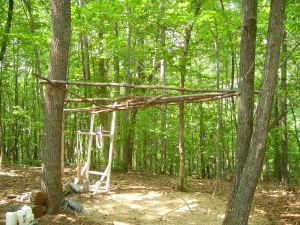Last Sunday’s view of the backyard, complete with Jeremiah Johnson-style striking equipment:
FSRI Contributors:
- Gillian Russell
- David Chopper Campbell
- kevinpreilly
- Randy Simpson, M.S.
- Robert Miller CPT CES PES
-
Recent Posts
Anatomy Resources
Blogroll
DIY Training Equipment
FSRI Clubs
FSRI Original Research
- Applying Sports Science to the Fighting Arts
- Understanding Karate by De-emphasizing Kata
- Epistemic Viciousness in the Martial Arts
- More on Perception: Don't Just Rely on Visual Input
- More on Rhabdomyolysis and the Fighting Arts
- Bernard Bettelheim: The Misadventures of a Missionary in 18th Century Okinawa
- Change Blindness and it's Relationship to Training
- Evidence Based Practice in the Fighting Arts: Appraisal and Suggestions
FSRI Training/Teaching Resources
- Regarding hurdler's Stretches and Kicking
- Stretches for Striking
- Basic Physical Training Concepts for Fighting Arts Practitioners
- Vertebral Artery and Carotid Artery Dissection Resulting From Mild Neck Trauma
- Back Brief
- Health, Injuries, Limitations, and Challenges
- Training & Conditioning
- More for the Core: Are Sit-ups Helping Your Lower Back, or Hurting?
- Stretches for Striking
- Basic Physical Training Resources for Fighting Arts Practitioners, pt. 2
Mugs and T-shirts
Recommended Fighting Arts
Recommended Trainers
Research Resources
- PubMed
- Internet Public Library
- Google Books
- InYo:The Journal of Alternative Perspectives on the Martial Arts and Sciences
- Athletic Insight: The Online Journal of Sport Psychology
- The British Journal of Sports Medicine
- Journal of Sports Science and Medicine
- Journal of Combative Sport
- Dept. of Justice Violent Crime Stats
- Google Scholar
Resources for Women Dealing with Violence
- Violence against women related resources at feminist.com
- Domestic Violence and Abuse: Help, Treatment, Intervention, and Prevention at Helpguide.org
- "911 for Women" Links Page for the Feminist Majority Foundation
- Domestic Violence Agencies on the Internet
- National Coalition Against Domestic Violence
Strength & Conditioning Resources
- Female Athletes and Serious Knee Injuries
- Fitness for the Fighting Arts
- National Exercise & Sports Trainers Association
- Sports Fitness Advisor
- Stumptuous
- National Academy of Sports Medicine
- Beast Skills Tutorials
- ACL Injury Prevention for Female Athletes (PEP Program)
- Race Rx Labs
- Link Related to the Q Angle
Useful Misc. Links
Past Articles:










 are available here.
are available here.